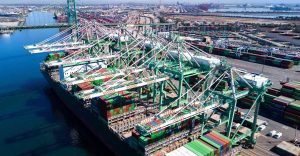Osaka Port is one of the most important and largest seaports in Japan, playing a key role in connecting Japan with the global economy. Established in 1868, Osaka Port has developed into a leading trade and cargo transport hub in the Asia-Pacific region. With its favorable geographical location and modern infrastructure, Osaka Port is an ideal destination for international import and export activities and logistics.
Geographical Location of Osaka Port
Strategic Location
Osaka Port is located in the Kansai region on Honshu Island, near the city of Osaka – one of Japan’s largest economic centers. The port’s strategic location makes it easy to connect with other major economic centers in Japan and countries in the region.
Distance to Major Cities
Osaka Port is about 500 km from Tokyo and about 40 km from Kyoto. With a modern transportation system including roads, railways, and airways, Osaka Port has the ability to quickly and efficiently connect with other economic areas both domestically and internationally.
Infrastructure and Equipment
Area and Depth
Osaka Port covers a vast area, including multiple terminals and modern warehouses. The port has a depth of up to 15 meters, allowing it to accommodate container ships and large cargo vessels. According to data from the Osaka Port Management Bureau, the port can handle more than 2.5 million TEUs (20-foot container units) annually.
Modern Equipment
Osaka Port is equipped with modern equipment such as container cranes, an automated cargo management system, and specialized transport vehicles. These devices help enhance efficiency and minimize cargo processing time. According to Mr. Hiroshi Tanaka, a logistics expert in Japan, “Osaka Port is one of the ports with the most advanced equipment, ensuring that cargo handling is done quickly and efficiently.”
Cargo Volume and Types of Cargo Handled
Cargo Volume
Osaka Port handles a large volume of goods annually. According to data from the Osaka Port Management Bureau, in 2023, the port handled over 85 million tons of cargo. This shows the strong development and importance of the port in international cargo flow.
Types of Cargo
The main types of cargo passing through Osaka Port include industrial goods, consumer goods, and raw materials. These items play a significant role in Japan’s import and export activities. Notably, industrial goods and raw materials account for a large share of the total cargo throughput at the port. According to Mr. Kenji Yamada, Executive Director of a major logistics company in Japan, “Osaka Port is a vital gateway for industrial goods and raw materials entering and leaving Japan.”
Economic Contribution of Osaka Port
Economic Role
Osaka Port plays an important role in Japan’s economic development. Not only does it create numerous jobs, but the port also drives the growth of related industries such as logistics, transport, and trade. According to research from the Japan Economic Research Institute, Osaka Port contributes about 4.5% of the GDP of the Kansai region.
Contribution to GDP
Annually, Osaka Port contributes billions of dollars to Japan’s GDP. It is estimated that the port contributes approximately 50 billion USD to Japan’s GDP each year. This underscores the port’s vital role in the national economy. The development of the port also strengthens Japan’s position on the international stage. According to a report by the World Bank, Osaka Port is one of the highest-performing ports in the Asia-Pacific region in terms of economic output.
Logistics Activities at Osaka Port
Modern Logistics System
Osaka Port boasts a modern and advanced logistics system, with logistics centers and warehouses equipped with high-tech technology. This helps optimize the transportation and storage of goods. Automated cargo management systems and advanced logistics software are widely applied at the port.
International Cooperation
Osaka Port has close cooperation relationships with many seaports and international partners. This enhances its connectivity and expands its global logistics network. According to Mr. Taro Sato, Director of International Relations at Osaka Port, “We always strive to maintain and develop cooperative relationships with international partners to improve service quality and expand our logistics network.”
Challenges and Opportunities
Despite its many advantages, Osaka Port also faces some challenges. One of the biggest challenges is the competition from other ports in the Asia-Pacific region. Additionally, climate change and environmental issues also present significant challenges for the port’s operations.
In addition to these challenges, Osaka Port also has many opportunities for development. The application of new technology and improvements in management processes is one of the major opportunities. Furthermore, the development of new maritime routes and free trade agreements also opens up many opportunities for Osaka Port.
Osaka Port is one of the most important and developed seaports in Japan, playing a crucial role in connecting Japan with the global economy. With its favorable geographical location, modern infrastructure, and significant economic role, Osaka Port continues to be a strategic hub for trade and cargo transport in the Asia-Pacific region. Data and opinions from logistics experts confirm the importance and future development prospects of the port.






